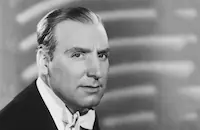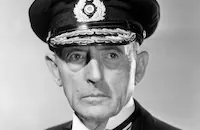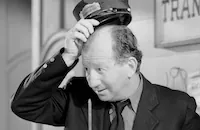The Lady and the Bandit

Brief Synopsis
Cast & Crew
Ralph Murphy
Louis Hayward
Patricia Medina
Suzanne Dalbert
Tom Tully
John Williams
Film Details
Technical Specs

Synopsis
In 18th century England, infamous bandit Dick Turpin and his partner, Tom King, terrorize the countryside with their daring holdups. After another narrow escape, Dick informs Tom he will be going to London the following day to purchase new clothes, but Tom suspects Dick will be making another attempt on Lord Willoughby, who was responsible for the false accusation that led to the execution of Dick's father years earlier. In London, Chief Constable of Police Sir Thomas DeVeil forces shady used-goods proprietor B. Hedger, with whom Dick has arranged a meeting, to give the bandit away. Dick evades the trap by taking refuge in the Theatre Royal, where he cajoles stage star David Garrick into supplying him with a private box for the performance. Seated in the box next to Dick is the formerly wealthy Lady Greene and her daughter Joyce. Believing Dick is a close acquaintance of Garrick's, Lady Greene befriends him. Dick, who is calling himself Richard Palmer, is smitten by Joyce, and she invites him to the Greenes's country home, St. Albans. Later, Dick is held up by a bandit identifying himself as "Dick Turpin," but who proves to be Archibald Puffin, an unemployed valet, whom Dick decides to hire to teach him manners. Returning to the country, Dick horrifies Tom by revealing that he wants to quit his life of crime to become a gentleman. Leaving Tom his beautiful horse, Black Bess, Dick departs for St. Albans. Six months later, Tom seeks out Dick to give him information about Willoughby and is astonished to find his friend married to Joyce and residing comfortably at St. Albans as a trader. When Dick discovers that Willoughby, Britain's ambassador to Austria, is returning from Vienna, he departs for London, telling Joyce nothing. Learning of Willoughby's plans, Dick holds up the ambassador's carriage and finds several letters on him, one to the Austrian Baroness Margaret of Luneberg, mistress of King George. The letter reveals Willoughby is plotting treason against the government. Dick challenges Willoughby to a duel, but he refuses, claiming that Dick is an unworthy opponent. Dick vows revenge before returning to St. Albans, where Lady Greene informs him that Joyce has discovered his true identity and wants nothing to do with him. Devastated, Dick agrees to leave without seeing Joyce, who has no knowledge of her husband's identity, but is being protected by her mother. Despondent, Dick returns to his former criminal life with Tom. One night when Black Bess is taken to replace a lame horse on the king's carriage. Dick sneaks to Baroness Margaret's nearby estate, and is caught by Cecile, Margaret's French maid, trying to claim Black Bess. Recognizing Dick from the many wanted posters scattered across the country, Cecile suggests a partnership as she has information on the arrival of Margaret's foreign visitors, who are steadily bringing in her jewelry to help fund Willoughby's plot, and Dick agrees. During a hazardous attack upon a shipment of newly minted coins, Tom is captured and Dick barely escapes. Dick then sneaks back into town to break Tom out of jail, but is injured during their flight. Tom takes his unconscious friend to St. Albans, where Joyce tends to her husband despite her mother's protests. When Joyce tells Dick she does not care about his past and wants to start out anew, he decides they should go to America as soon as possible. After Dick has recovered from his wounds, Tom is angered over his determination to move to America. When Tom reveals suspicions that Austrian troops are being brought to England to begin Willoughby's uprising, however, Dick forces a hasty meeting with the Prime Minister, Sir Robert Walpole, and gives him the letter taken from Willoughby, but declines to identify himself. Furious that Dick has returned to Joyce, Cecile betrays him to Margaret, who sends her guard after him. Intent on keeping Joyce from conspiracy charges, Dick insists they split up and meet later at the harbor. When dragoons try to prevent Dick's getaway, Tom makes a suicidal dash to cover for his friend, who then sets off at a furious pace for York to prove he was not at St. Albans. Joyce is held on suspicion of harboring Turpin, although the police do not suspect the bandit and Palmer are one and the same. Dick makes it to York in time to hold up the postal carriage to prove his whereabouts and discovers Garrick on board. Recognizing him, the actor lets Dick go unmolested, but after the harsh ride, Black Bess collapses and dies, allowing Dick's capture. At Kensington Palace, King George accuses Margaret and Willoughby of treason, then meets with Walpole, who asks that Dick, already tried and sentenced to death, be pardoned. The king agrees to banish Dick to America, but his message is not received in York in time and Dick is hanged. Walpole sees Joyce and Lady Greene off on the ship to America, and assures them that Dick is recognized as a hero and patriot.

Director
Ralph Murphy
Cast

Louis Hayward
Patricia Medina
Suzanne Dalbert

Tom Tully

John Williams
Malu Gatica

Alan Mowbray
Lumsden Hare
Barbara Brown
Malcolm Keen
Stapleton Kent
Sheldon Jett
George Baxter
Ivan Triesault
Norman Leavitt

Frank Reicher
Guy Kingsford
Al Ferguson
Charles Heard
Frank Hagney
John Sheehan
Gerald Oliver Smith

Leonard Carey
Leslie Denison
Al Boles
David Dunbar
Barry Brooks
Tudor Owen
Ben Welden
Art Loeb
Lester Matthews
James Fairfax
Jimmy Aubrey
J. P. Mcgowan
Gene Collins

Hank Mann
Cosmo Sardo
Jock O'mahoney
Crew
Frederick Briskin
George Brooks
Harry Joe Brown
Frank Burt
Clay Campbell
Lambert Day
Jack Dewitt
George Duning
Henry Freulich
Gene Havlick
Helen Hunt
Robert Libott
Duncan Renaldo
Herbert Stewart
Morris Stoloff
Frank [a.] Tuttle
Harry Waxman

Film Details
Technical Specs

Quotes
Trivia
Notes
The working title of this film, Dick Turpin's Ride, was also the British release title. The film was copyrighted twice, first on June 1, 1951, under the working title, Dick Turpin's Ride, then on July 6, 1951 under its release title, The Lady and the Bandit. The later copyright date lists a longer running time of 93 minutes.
The real Dick Turpin (1706-1739) was born in Hempstead, Essex, England and was a butcher's apprentice before turning to a life of crime as a smuggler, housebreaker, horse thief and highwayman. Like the film, Turpin's friend and partner was Tom King. Unlike the film, however, Turpin was hanged for murder. The famous York ride credited to Turpin was probably carried out by Swift John Nevison (1639-1684) who was, like Turpin's character in the film, attempting to establish an alibi. Turpin's exploits made him a legendary figure in popular culture. Portions of the film were shot on location in England.
Another film based on Alfred Noyes's poem was the 1951 Allied Artists production The Highwayman. In 1925 John G. Blystone directed Tom Mix in the Fox Film Corp. production Dick Turpin (see AFI Catalog of Feature Films, 1921-30). The character also appears as part of a carnival attraction in the 1967 British film Far from the Madding Crowd.













